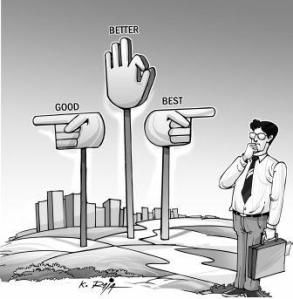You’d think brands would know what the customer wanted at this stage of the game, right? It’s 2015 and companies left and right keep talking about their new mandate of delivering on a quality customer experience. providing a powerful and memorable customer experience, etc. etc… It’s almost as if what has happened up to this point didn’t matter or was not a quality experience. I guess, what I want to know is, what have I been getting all of these years?
You might want to say this out loud: “Companies just now, are starting to actually care and do something about me and for me, the customer.” What changed? What happened? What took you so long? You have to wonder, could you have actually been getting more out of your brand experiences all this time? I almost feel like I’ve been short-changed. Until now.
I’ll tell you what happened and it’s really pretty simple; and most of you will slough it off as yet another social media justification post, but it’s true. What happened is social media happened. Social gave the customer a voice they never had.
For the longest time, companies just pushed out what they thought the customer needed and wanted. They didn’t really ask. Sure, they might have done the occasional test/focus group or survey but those were never a large enough sample size. Back in the day, wasn’t customer feedback the 800 number you called to leave your complaint? You never really expected them to get back to you. Did you?
Of course you know this but I’m going to say it again anyway to drive the point home. Social media has allowed customers to have a real voice on so many levels/platforms now. You can write 1000 words diatribes praising or bashing a company. You can voice your displeasure immediately in 140 characters or less on Twitter. You can rate your experience via Yelp or you can Video or take pics of how bad the experience was via YouTube or Instagram. Clearly the customer now has a voice; and that scares the crap out of really large brands as well as small and medium sized businesses.
Why does that scare them? Because the truth actually might hurt them for a change.
I hate when I hear the term, “the customer now has the upper hand.” That’s not what this is about. Customers should not have to compete with a brand. They just want a fair and equitable brand experience. The truth finally evens the playing field. So if consumers are competing, which they shouldn’t be, at least brands know that there are eyes and ears on the customer experience now.
Hard to believe that brands are just now starting to talk about and acknowledge the need for delivering a superior customer experience, but hey, talking is one thing, doing is another. Will the customer rise? Is the customer experience the brand experience? Or is it just lip service for 2015?









 We hear so much chatter that companies have to be participating in social media. The chatter then leads into who should do it….and Voila! A single person is assigned to it. That person is usually born of the marketing or public relations (PR) team and the goal is rather simple: 1. Listen and 2. chat it up in an effort to create customer relationships. Customer Relationships! are you kidding me?!?! Who in marketing or PR has ever had to directly sell or service a customer (let me help you – not many)? So why don’t we ever hear about social media from the people who are responsible for managing direct customer experiences on a daily basis? That’s right, the customer service teams, talk about resources! Customer support, service, tech support usually have dozens if not thousands of company representatives waiting for you to call. Ahh, therein lies the issue. Customer service is typically reactive and most likely engineered to react via the telephone.
We hear so much chatter that companies have to be participating in social media. The chatter then leads into who should do it….and Voila! A single person is assigned to it. That person is usually born of the marketing or public relations (PR) team and the goal is rather simple: 1. Listen and 2. chat it up in an effort to create customer relationships. Customer Relationships! are you kidding me?!?! Who in marketing or PR has ever had to directly sell or service a customer (let me help you – not many)? So why don’t we ever hear about social media from the people who are responsible for managing direct customer experiences on a daily basis? That’s right, the customer service teams, talk about resources! Customer support, service, tech support usually have dozens if not thousands of company representatives waiting for you to call. Ahh, therein lies the issue. Customer service is typically reactive and most likely engineered to react via the telephone.